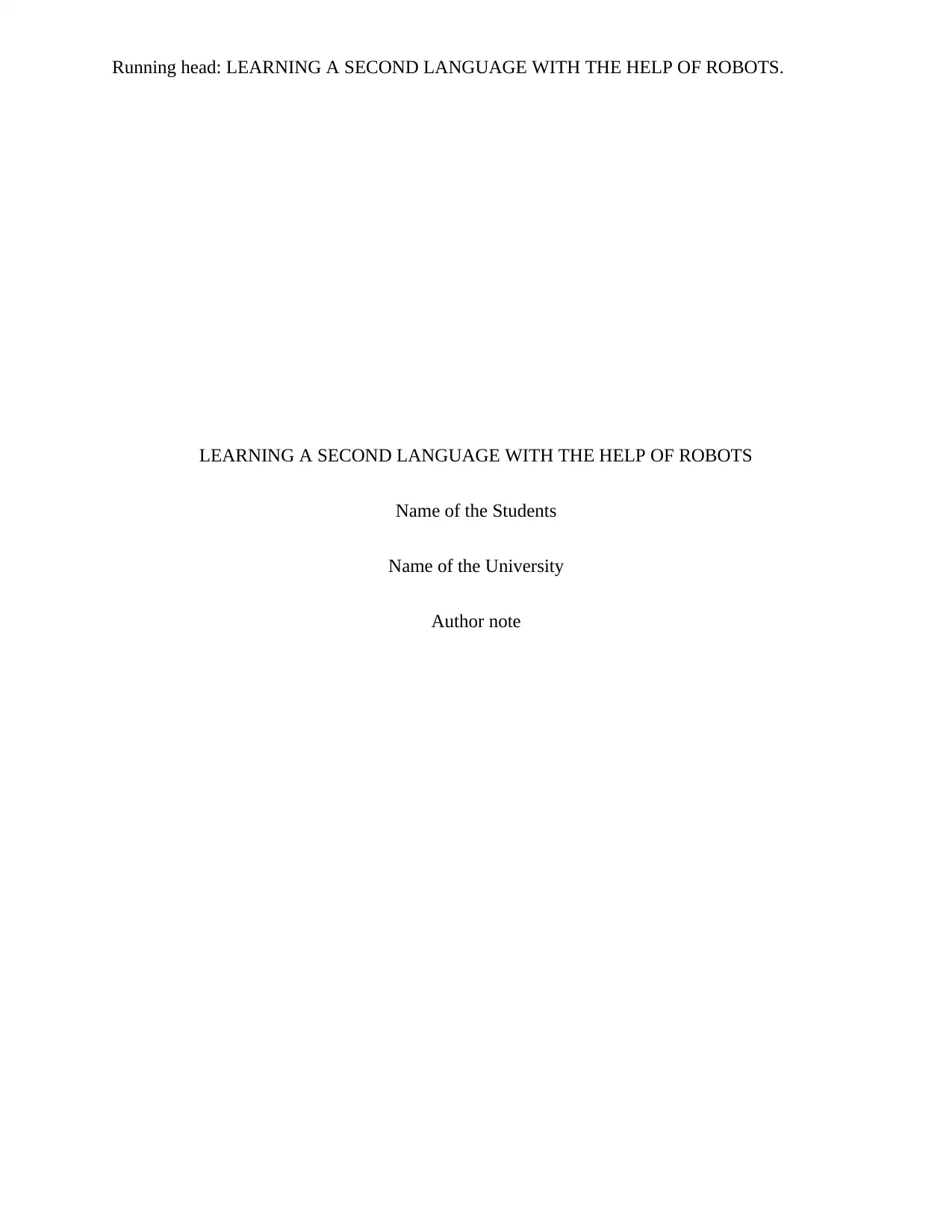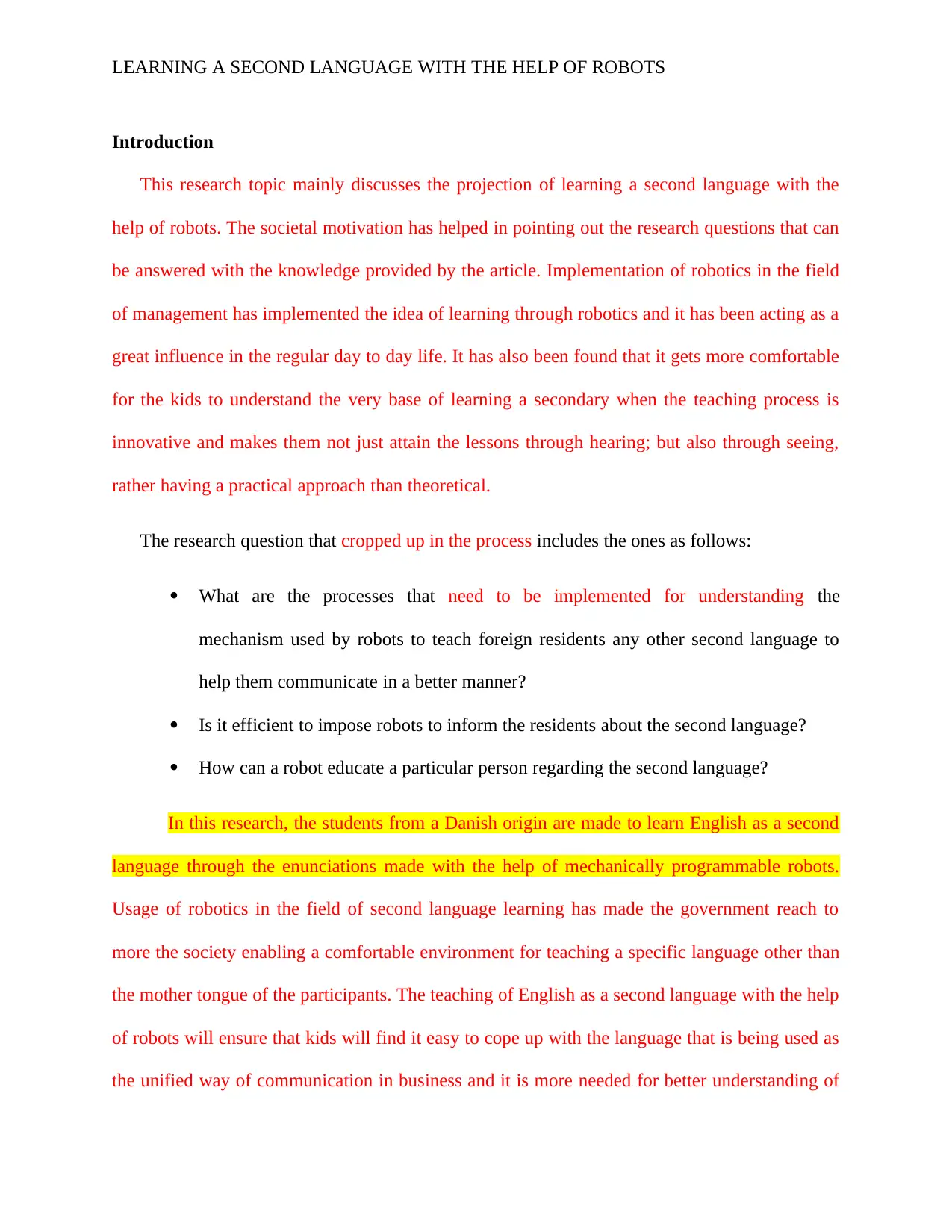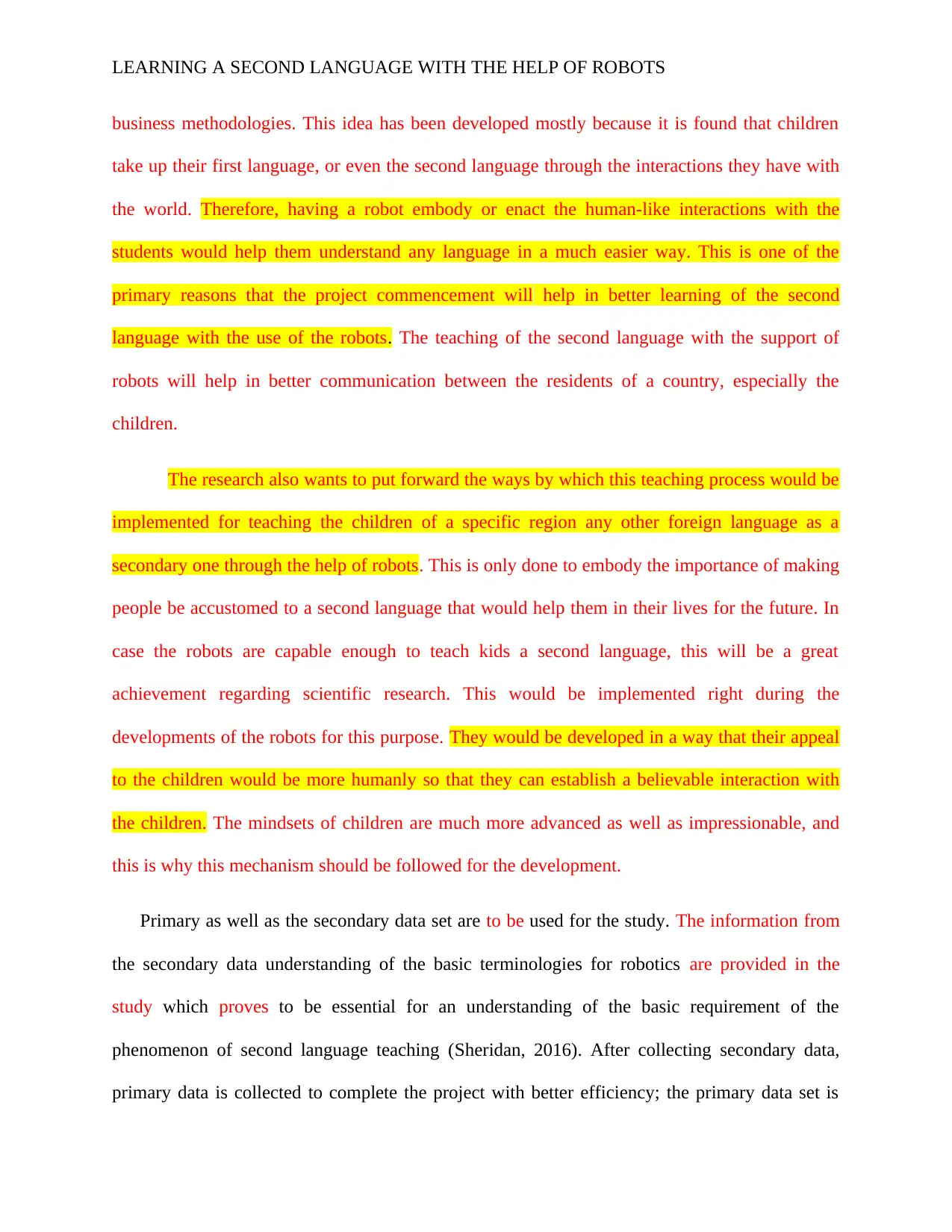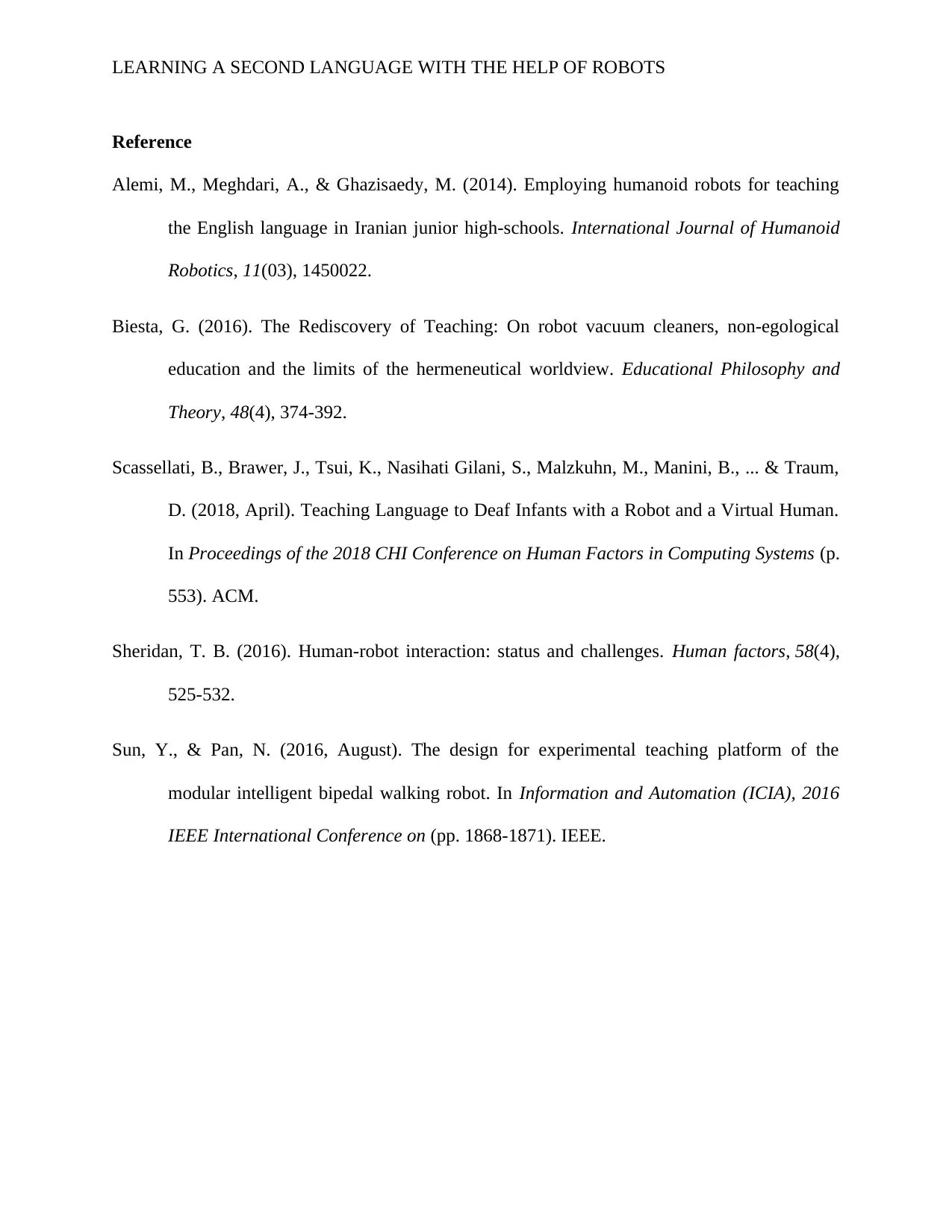Learning a Second Language with the Help of Robots
VerifiedAdded on 2023/05/27
|7
|1508
|370
AI Summary
This article discusses the implementation of robotics in teaching a second language and its benefits. It explores the research questions related to the mechanism used by robots to teach foreign residents a second language, the efficiency of using robots for language teaching, and how robots can educate a person regarding a second language. The article also presents the ways by which this teaching process can be implemented and the challenges that come with it.
Contribute Materials
Your contribution can guide someone’s learning journey. Share your
documents today.

Running head: LEARNING A SECOND LANGUAGE WITH THE HELP OF ROBOTS.
LEARNING A SECOND LANGUAGE WITH THE HELP OF ROBOTS
Name of the Students
Name of the University
Author note
LEARNING A SECOND LANGUAGE WITH THE HELP OF ROBOTS
Name of the Students
Name of the University
Author note
Secure Best Marks with AI Grader
Need help grading? Try our AI Grader for instant feedback on your assignments.

LEARNING A SECOND LANGUAGE WITH THE HELP OF ROBOTS
Introduction
This research topic mainly discusses the projection of learning a second language with the
help of robots. The societal motivation has helped in pointing out the research questions that can
be answered with the knowledge provided by the article. Implementation of robotics in the field
of management has implemented the idea of learning through robotics and it has been acting as a
great influence in the regular day to day life. It has also been found that it gets more comfortable
for the kids to understand the very base of learning a secondary when the teaching process is
innovative and makes them not just attain the lessons through hearing; but also through seeing,
rather having a practical approach than theoretical.
The research question that cropped up in the process includes the ones as follows:
What are the processes that need to be implemented for understanding the
mechanism used by robots to teach foreign residents any other second language to
help them communicate in a better manner?
Is it efficient to impose robots to inform the residents about the second language?
How can a robot educate a particular person regarding the second language?
In this research, the students from a Danish origin are made to learn English as a second
language through the enunciations made with the help of mechanically programmable robots.
Usage of robotics in the field of second language learning has made the government reach to
more the society enabling a comfortable environment for teaching a specific language other than
the mother tongue of the participants. The teaching of English as a second language with the help
of robots will ensure that kids will find it easy to cope up with the language that is being used as
the unified way of communication in business and it is more needed for better understanding of
Introduction
This research topic mainly discusses the projection of learning a second language with the
help of robots. The societal motivation has helped in pointing out the research questions that can
be answered with the knowledge provided by the article. Implementation of robotics in the field
of management has implemented the idea of learning through robotics and it has been acting as a
great influence in the regular day to day life. It has also been found that it gets more comfortable
for the kids to understand the very base of learning a secondary when the teaching process is
innovative and makes them not just attain the lessons through hearing; but also through seeing,
rather having a practical approach than theoretical.
The research question that cropped up in the process includes the ones as follows:
What are the processes that need to be implemented for understanding the
mechanism used by robots to teach foreign residents any other second language to
help them communicate in a better manner?
Is it efficient to impose robots to inform the residents about the second language?
How can a robot educate a particular person regarding the second language?
In this research, the students from a Danish origin are made to learn English as a second
language through the enunciations made with the help of mechanically programmable robots.
Usage of robotics in the field of second language learning has made the government reach to
more the society enabling a comfortable environment for teaching a specific language other than
the mother tongue of the participants. The teaching of English as a second language with the help
of robots will ensure that kids will find it easy to cope up with the language that is being used as
the unified way of communication in business and it is more needed for better understanding of

LEARNING A SECOND LANGUAGE WITH THE HELP OF ROBOTS
business methodologies. This idea has been developed mostly because it is found that children
take up their first language, or even the second language through the interactions they have with
the world. Therefore, having a robot embody or enact the human-like interactions with the
students would help them understand any language in a much easier way. This is one of the
primary reasons that the project commencement will help in better learning of the second
language with the use of the robots. The teaching of the second language with the support of
robots will help in better communication between the residents of a country, especially the
children.
The research also wants to put forward the ways by which this teaching process would be
implemented for teaching the children of a specific region any other foreign language as a
secondary one through the help of robots. This is only done to embody the importance of making
people be accustomed to a second language that would help them in their lives for the future. In
case the robots are capable enough to teach kids a second language, this will be a great
achievement regarding scientific research. This would be implemented right during the
developments of the robots for this purpose. They would be developed in a way that their appeal
to the children would be more humanly so that they can establish a believable interaction with
the children. The mindsets of children are much more advanced as well as impressionable, and
this is why this mechanism should be followed for the development.
Primary as well as the secondary data set are to be used for the study. The information from
the secondary data understanding of the basic terminologies for robotics are provided in the
study which proves to be essential for an understanding of the basic requirement of the
phenomenon of second language teaching (Sheridan, 2016). After collecting secondary data,
primary data is collected to complete the project with better efficiency; the primary data set is
business methodologies. This idea has been developed mostly because it is found that children
take up their first language, or even the second language through the interactions they have with
the world. Therefore, having a robot embody or enact the human-like interactions with the
students would help them understand any language in a much easier way. This is one of the
primary reasons that the project commencement will help in better learning of the second
language with the use of the robots. The teaching of the second language with the support of
robots will help in better communication between the residents of a country, especially the
children.
The research also wants to put forward the ways by which this teaching process would be
implemented for teaching the children of a specific region any other foreign language as a
secondary one through the help of robots. This is only done to embody the importance of making
people be accustomed to a second language that would help them in their lives for the future. In
case the robots are capable enough to teach kids a second language, this will be a great
achievement regarding scientific research. This would be implemented right during the
developments of the robots for this purpose. They would be developed in a way that their appeal
to the children would be more humanly so that they can establish a believable interaction with
the children. The mindsets of children are much more advanced as well as impressionable, and
this is why this mechanism should be followed for the development.
Primary as well as the secondary data set are to be used for the study. The information from
the secondary data understanding of the basic terminologies for robotics are provided in the
study which proves to be essential for an understanding of the basic requirement of the
phenomenon of second language teaching (Sheridan, 2016). After collecting secondary data,
primary data is collected to complete the project with better efficiency; the primary data set is

LEARNING A SECOND LANGUAGE WITH THE HELP OF ROBOTS
used to perform the project in a better way. The primary data is the set of information collected
to find out how children can be made comfortable when they are made to learn through an
external source like a robot.
Data were obtained with the help of setting up a questionnaire for the kids who have been
helped by the robots. These would act as the centrally realized fact that leads in efficient
completion of the project.
The contribution of this research is beneficiary to both the society as well as the technical
advancements of teaching processes through Artificial Intelligence. In case this method is well
implemented, and the success rate of this process is very high; this would be the chief goal that
the project would like to present as the deliverable. With an increase in the success rate of the
experiment it can be concluded that the implementation of robotics in the field of secondary
language learning has been beneficial to humanity as well as the technical world.
The method of study that is taken into consideration in this situation is the better
assessment of the project through power point presentations. The children are thus made part of
the experiment but before that it is made sure that they are comfortable with the learning process
through the screening of the Techtronic's and the use of robotics.
The challenges that are present in the main idea behind the project include the development
of naturalistic investigation which is one of the main reasons for the organization to perform
informally. This leads to the fact that the commencement of the project would get hampered. The
ASR system is not very reliant as the processor is not efficient to the mark. The timing of the
response set by the robot is also a primary reason that acts as a challenge to the system
informatics. This is the reason that the efficiency of the project is a challenge. Technical issue
used to perform the project in a better way. The primary data is the set of information collected
to find out how children can be made comfortable when they are made to learn through an
external source like a robot.
Data were obtained with the help of setting up a questionnaire for the kids who have been
helped by the robots. These would act as the centrally realized fact that leads in efficient
completion of the project.
The contribution of this research is beneficiary to both the society as well as the technical
advancements of teaching processes through Artificial Intelligence. In case this method is well
implemented, and the success rate of this process is very high; this would be the chief goal that
the project would like to present as the deliverable. With an increase in the success rate of the
experiment it can be concluded that the implementation of robotics in the field of secondary
language learning has been beneficial to humanity as well as the technical world.
The method of study that is taken into consideration in this situation is the better
assessment of the project through power point presentations. The children are thus made part of
the experiment but before that it is made sure that they are comfortable with the learning process
through the screening of the Techtronic's and the use of robotics.
The challenges that are present in the main idea behind the project include the development
of naturalistic investigation which is one of the main reasons for the organization to perform
informally. This leads to the fact that the commencement of the project would get hampered. The
ASR system is not very reliant as the processor is not efficient to the mark. The timing of the
response set by the robot is also a primary reason that acts as a challenge to the system
informatics. This is the reason that the efficiency of the project is a challenge. Technical issue
Secure Best Marks with AI Grader
Need help grading? Try our AI Grader for instant feedback on your assignments.

LEARNING A SECOND LANGUAGE WITH THE HELP OF ROBOTS
that might arise is another primary reason behind the decrease in the success rate of the
technology.
No such alternative approach will provide equal efficiency. The main application of the work
might be to prosecute the project to make the kids be familiar with a second language in a fluent
way as learning the second language will act beneficial for better commencement in their lives
(Biesta, 2016).
Conclusion
It can thus be concluded that with the help of the approach that is used in the dispensation of
the organization, the main effect that gets prosecuted would include the better management of
the system, and the benefit would be enjoyed by the kids as well as adults who are not very well
prone to the second language. This essay portrays the fact that the management of the language
teaching is very well performed with the help of the robots as they provide both audio-visual
effect which helps in better; earning of the language.
that might arise is another primary reason behind the decrease in the success rate of the
technology.
No such alternative approach will provide equal efficiency. The main application of the work
might be to prosecute the project to make the kids be familiar with a second language in a fluent
way as learning the second language will act beneficial for better commencement in their lives
(Biesta, 2016).
Conclusion
It can thus be concluded that with the help of the approach that is used in the dispensation of
the organization, the main effect that gets prosecuted would include the better management of
the system, and the benefit would be enjoyed by the kids as well as adults who are not very well
prone to the second language. This essay portrays the fact that the management of the language
teaching is very well performed with the help of the robots as they provide both audio-visual
effect which helps in better; earning of the language.

LEARNING A SECOND LANGUAGE WITH THE HELP OF ROBOTS
Reference
Alemi, M., Meghdari, A., & Ghazisaedy, M. (2014). Employing humanoid robots for teaching
the English language in Iranian junior high-schools. International Journal of Humanoid
Robotics, 11(03), 1450022.
Biesta, G. (2016). The Rediscovery of Teaching: On robot vacuum cleaners, non-egological
education and the limits of the hermeneutical worldview. Educational Philosophy and
Theory, 48(4), 374-392.
Scassellati, B., Brawer, J., Tsui, K., Nasihati Gilani, S., Malzkuhn, M., Manini, B., ... & Traum,
D. (2018, April). Teaching Language to Deaf Infants with a Robot and a Virtual Human.
In Proceedings of the 2018 CHI Conference on Human Factors in Computing Systems (p.
553). ACM.
Sheridan, T. B. (2016). Human-robot interaction: status and challenges. Human factors, 58(4),
525-532.
Sun, Y., & Pan, N. (2016, August). The design for experimental teaching platform of the
modular intelligent bipedal walking robot. In Information and Automation (ICIA), 2016
IEEE International Conference on (pp. 1868-1871). IEEE.
Reference
Alemi, M., Meghdari, A., & Ghazisaedy, M. (2014). Employing humanoid robots for teaching
the English language in Iranian junior high-schools. International Journal of Humanoid
Robotics, 11(03), 1450022.
Biesta, G. (2016). The Rediscovery of Teaching: On robot vacuum cleaners, non-egological
education and the limits of the hermeneutical worldview. Educational Philosophy and
Theory, 48(4), 374-392.
Scassellati, B., Brawer, J., Tsui, K., Nasihati Gilani, S., Malzkuhn, M., Manini, B., ... & Traum,
D. (2018, April). Teaching Language to Deaf Infants with a Robot and a Virtual Human.
In Proceedings of the 2018 CHI Conference on Human Factors in Computing Systems (p.
553). ACM.
Sheridan, T. B. (2016). Human-robot interaction: status and challenges. Human factors, 58(4),
525-532.
Sun, Y., & Pan, N. (2016, August). The design for experimental teaching platform of the
modular intelligent bipedal walking robot. In Information and Automation (ICIA), 2016
IEEE International Conference on (pp. 1868-1871). IEEE.

LEARNING A SECOND LANGUAGE WITH THE HELP OF ROBOTS
1 out of 7
Related Documents
Your All-in-One AI-Powered Toolkit for Academic Success.
+13062052269
info@desklib.com
Available 24*7 on WhatsApp / Email
![[object Object]](/_next/static/media/star-bottom.7253800d.svg)
Unlock your academic potential
© 2024 | Zucol Services PVT LTD | All rights reserved.





